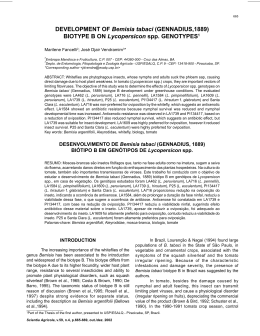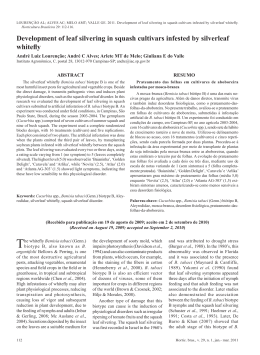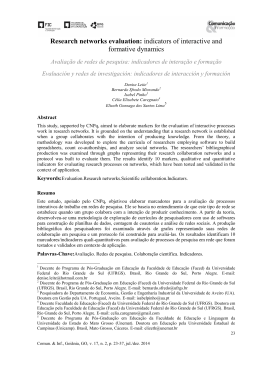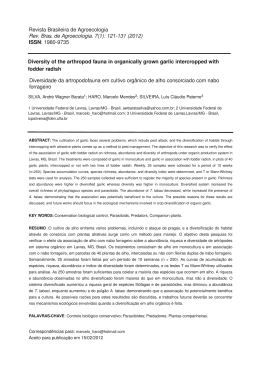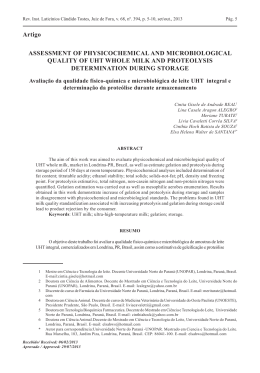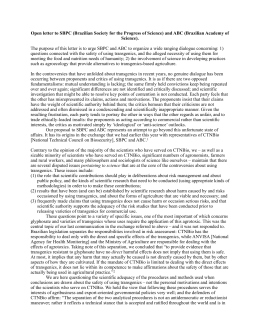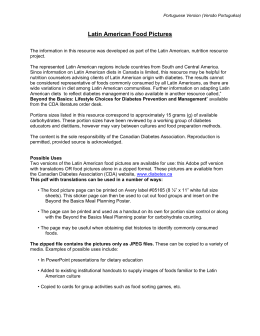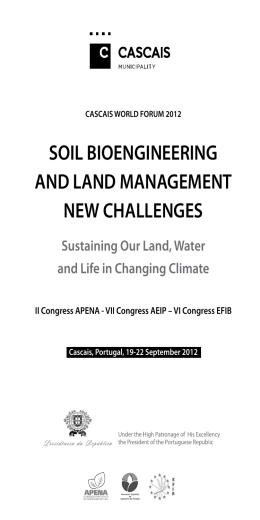1 Factors influencing Bemisia tabaci, Brevicoryne brassicae and Thrips tabaci abundance on kale (Brassica oleracea var. acephala) Germano Leão Demolin Leite1; Marcelo Picanço2; Isabella de Souza Gomes Campelo2; Marcelo Fialho Moura2 1 UFMG, Núcleo de Ciências Agrárias, C. Postal 135, 39.404-006 Montes Claros-MG;2 UFV, Departamento de Biologia animal, 36571-000 Viçosa-MG; 3 UFV, Departamento de Química. RESUMO Fatores influenciando a abundância de Bemisia tabaci, Brevicoryne brassicae e Thrips tabaci em couve (Brassica oleracea var. acephala) O objetivo deste estudo foi investigar as relações entre predadores e parasitóides, composição química foliar, níveis foliares de nitrogênio e de potássio, pluviosidade total, umidade relativa, insolação e temperatura média na abundância de Bemisia tabaci (Genn.), Brevicoryne brassicae L., e Thrips tabaci Lind. em couve (Brassica oleracea L. var. acephala). A temperatura média, insolação e umidade relativa correlacionaram com nonacosano foliar em couve que, por sua vez, esteve associado com o aumento populacional de pulgões. Foi observada uma tendência na redução de pulgões, de moscabranca e de tripes com pluviosidade total. A população de pulgões tendeu a decrescer enquanto a de tripes e de mosca-branca tendeu a aumentar com o aumento da temperatura média. Adialytus spp. foi um fator limitante no aumento na população de B. brassicae. Palavras-chave:: dinâmica populacional, nonacosano, fatores climáticos, Braconidae. ABSTRACT The objectives of this study were to investigate the relationships between predators and parasitoids, leaf chemical composition, levels of leaf nitrogen and potassium, total rainfall, relative humidity, sunlight and median temperature on the abundance of Bemisia tabaci (Genn.), Brevicoryne brassicae L., and Thrips tabaci Lind. in kale (Brassica oleracea L. var. acephala). Median temperature, sunlight and relative humidity correlated to the amount of leaf nonacosane in kale which in turn was associated with population increase of the aphid. A tendency in the reduction of aphids, whitefly, and thrips populations with increase in total rainfall was observed. Aphid population tended to decrease while that of thrips and whitefly populations tended to increase as the average temperature increased. Adialytus spp. represented a limiting factor for increases in population of B. brassicae. Keywords: dynamic population, nonacosane, climatic factors, Braconidae. 2 Kale Brassica oleracea L. var. acephala, cultivated in several countries, is attacked by several pests such as whitefly Bemisia tabaci (Genn.) (Homoptera: Aleyrodidade), aphid Brevicoryne brassicae (L.) (Homoptera: Aphididae), and Thrips tabaci Lind. (Thysanoptera: Thripidae). In Brazil, insects attacking kale are controlled by blanket spraying with foliar insecticides. The frequency of insecticide applications is determined by the degree of damage, which is heavily influenced by cosmetic considerations (Leite et al., 1996). One of the principal reasons for extensive insecticide application is the lack of information on factors that control insect population. Such information could facilitate the prediction of insect attack, which in turn could reduce economic losses. Several factors such as climatic conditions, crop fertility status, natural enemies, and leaf chemical composition can influence insect population on plants (Horowitz, 1986; Leite et al., 1996; Gonçalves, 1997; Eigenbrode & Pillai, 1998; Hooks et al., 1998). However, these factors have been little studied in kale. The objectives of this study were to correlate abundance of natural enemies, levels of chemical composition, levels of N and K in leaves, total rainfall, relative humidity, sunlight and median temperature with the abundance of whitefly, aphids and thrips attack in kale, under field conditions. MATERIAL AND METHODS This experiment was conducted using two kale plantations of Brassica oleraceae L. var. acephala genotype “Talo Roxo” in Viçosa, State of Minas Gerais, Brazil. The first kale plantation was evaluated from March (30 days old at evaluation time) to May of 1999 and the second between August (15 days old evaluation time) to November of 1999 and planted in the same area. Kale cultivar had 3,000 (three thousand) plants spaced 0.5 m apart within rows and 1.0 m between rows. The seven periphery rows and the first twelve plants on each end of the row formed the outer border and the remaining planting was the sampling area. The beating tray method (Leite, 2000) was used to estimate weekly the number of adult whitefly, thrips, predators and parasitoids and direct counting for adults and nymphs aphids present in first expanded leaf form from each of 10 plant’s apex/plantation. The analyses to identify the leaf chemical composition, levels of leaf nitrogen and potassium and climatic data are described following Leite (2000). The data were submitted to multiple regression analysis (P < 0.05) and paramethers utilized in the equations were significant (P < 0.05). RESULTS AND DISCUSSION Several peaks were recorded on GC/MS analysis of the hexane extracts but only nonacosane was identified by the mass spectra database due to a similarity index of 93%. 3 The presence of nonacosane was confirmed with standard and quantified by GC. Among the factors studied, sunlight (X), median temperature (Z) and relative humidity (W) correlated with nonacosane (y = 101.110 +3.644*X –0.905*Z –1.185*W, R2 = 0.99, P < 0.0001). The leaf nonacosane in kale, a principal component of wax in the Brassicaceae (Eigenbrode & Pillai, 1998), has been related to plant adoption to hydric stress (Hull et al., 1975). Increases in median temperature and relative humidity and decrease in nonacosane content were accompanied by a decrease in B. brassicae density (Figure 1). Kale genotypes which possess high wax levels have been reported to be more susceptible to B. brassicae attack but more resistant to Myzus persicae (Sulzer) (Homoptera: Aphididae) (Paula et al., 1995; Leite et al., 1996). However, no relationship between nonacosane and whitefly and thrips was observed in kale. The general accepted hypothesis is that the wax components rarely deter herbivore attack and more commonly stimulate them (Woodhead & Chapman, 1986), such as observed here. Total rainfall (X), median temperature (Z) and relative humidity (W) correlated with B. tabaci (y = -2.324 –0.001*X +0.022*Z +0.028*W, R2 = 0.90, P < 0.05). In general, increases in temperature favor the B. tabaci and T. tabaci populations while heavy rain and high humidity are deleterious to these insects (Horowitz, 1986; Lorini & Dezordi, 1990; Horowitz et al., 1994; Gonçalves, 1997). On the other hand, high temperatures and rainfall are important mortality factors of aphids in field (Walker et al., 1984; Nakata, 1995). Positive correlation was observed between Adyalitus spp. and B. brassicae (Figure 1). The parasite Adialytus spp. appeared to be the limiting factor for population increase of B. Brassicae, such as observed by Hooks et al. (1998) with the Aphis gossypii (Glover) (Homoptera: Aphididae) population in zucchini. Low densities of the remaining natural enemies studied were observed and appeared to be the probable factors responsible for the lack of correlations with whitefly, thrips and aphid populations in kale. In summary, the B. tabaci can be an important pest in kale producing regions of higher temperature and smaller rainfall. Brevicoryne brassicae population in the kale was affected positively by nonacosane and hence, in regions where there is a high incidence of this pest (regions of moderate temperature) one should choose varieties with a low leaf wax content. Natural enemies, especially the parasitoid Adialytus spp. can be important controlling agents of the aphid population in kale. REFERENCES EIGENBRODE, S.D.; PILLAI, S.K. Neonate Plutella xylostella responses to surface wax components of a resistant cabbage (Brassica oleracea). Journal of Chemical Ecology, New 4 York, v.24, n.10, p.1611-1627, 1998 GONÇALVES, P.A.S. Flutuação populacional de tripes, Thrips tabaci Lind., em cebola em Ituporanga, Santa Catarina. Anais da Sociedade Entomológica do Brasil, Londrina, v.26, n.2, p.365-369, 1997. HOOKS, C.R.R.; VALENZUELA, H.R.; DEFRANK, J. Incidence of pests and arthropod natural enemies in zucchini grown with living mulches. Agriculture, Ecosystems and Environment, College Park, v.69, n.3, p.217-231, 1998 HOROWITZ, A.R. Population dynamics of Bemisia tabaci (Gennadius): with special emphasis on cotton fields. Agriculture, Ecosystems and Environment, College Park. v.17, n.1-2, p.37-47, 1986. HOROWITZ, A.R.; FORER, G.; ISHAAYA, I. Managing resistance in Bemisia tabaci in Israel with emphasis on cotton. Pesticide Science, W Sussex, v.42, n.2, p.113-122, 1994. HULL, H.M.; MORTON, H.L.; WHARRIE, J.R. Environmental influences on cuticle development and resultant foliar penetration. Botanica Review, v.41, p.421-452, 1975. LEITE, G.L.D.; PICANÇO, M.; BASTOS, C.S.; ARAÚJO, J.M.; AZEVEDO, A.A. Resistência de clones de couve comum ao pulgão verde. Horticultura Brasileira, Brasília, v.14, n.2, p.178-181, 1996. LEITE, G.L.D. Fatores que influenciam a intensidade de ataque de mosca-branca em tomateiro. Viçosa: UFV, 2000, 46p. (Tese de Doutorado). LORINI, I.; DEZORDI, J. Flutuação populacional de Thrips tabaci Lindeman, 1888 (Thysanoptera: Thipidae) na cultura da cebola. Anais da Sociedade Entomológica do Brasil, Londrina, v.19, p.361-365, 1990. NAKATA, T. Population fluctuations of aphids and their natural enemies on potato in Hokkaido, Japan. Applied Entomology and Zoology, Tokyo, v.30, n.1, p.129-138, 1995. PAULA, S.V.; PICANÇO, M.; KOGA, F.H.; MORÃES, J.C. Resistência de sete clones de couve comum à Brevicoryne brassicae (L.) (Homoptera: Aphididae). Anais da Sociedade Entomológica do Brasil, Londrina, v.24, n.1, p.99-104, 1995. WALKER, G.P.; NAUTL, L.R.; SIMONET, D.E. Natural mortality factors acting on potato aphid (Macrosiphum euphorbiae) populations in processing-tomato fields in Ohio. Environmental Entomology, Lanham, v.13, n.3, p.724-732, 1984. WOODHEAD, S.; CHAPMAN, R.F. Insect behaviour and the chemistry of plant surface waxes. In: JUNIPER, B. E.; SOUTHWOOD, T. R. E. (Eds.) Insect and the plant surface. London: Edward Arnold, 1986. pp. 123-135. 5
Download
